
Carburetor VAZ 2106: purpose, device, malfunctions, adjustment
Content
The stable operation of a carburetor engine directly depends on the performance of the carburetor itself. Until recently, cars of the VAZ family were equipped with a fuel supply system using this unit. The carburetor requires periodic maintenance, which is faced by almost every Zhiguli owner. Cleaning and adjustment work can be done on your own, for which it is enough to familiarize yourself and follow the step-by-step instructions.
Carburetor VAZ 2106
The VAZ "six" was produced by the Volga Automobile Plant for 30 years, from 1976 to 2006. The car was equipped with carburetor engines with a volume of 1,3 liters to 1,6 liters. Various carburetors were used in the fuel system, but Ozone was the most common.

What is it for
For any carburetor engine, an integral unit is the carburetor, which is designed to prepare the optimal composition of the fuel-air mixture by mixing air and fuel, as well as to supply this mixture to the cylinders of the power unit. For more efficient combustion of fuel, mixing with air must take place in certain proportions, usually 14,7: 1 (air / gasoline). Depending on the operating mode of the engine, the ratio may vary.
Carburetor device
Whatever the carburetor is installed on the VAZ 2106, the differences between them are minimal. The main systems of the node under consideration are:
- idle system;
- float chamber;
- econostat;
- accelerator pump;
- transition system;
- starting system.
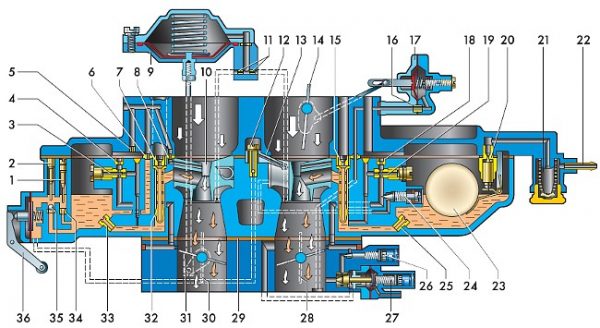
For a better understanding of the operation of the device, the listed systems should be considered in more detail.
Idling system
The idle speed system (CXX) is designed to maintain a stable engine speed when the throttle is closed. In this operating mode, the engine is powered without assistance. The fuel is taken by the system from the float chamber and mixed with air in the emulsion tube.
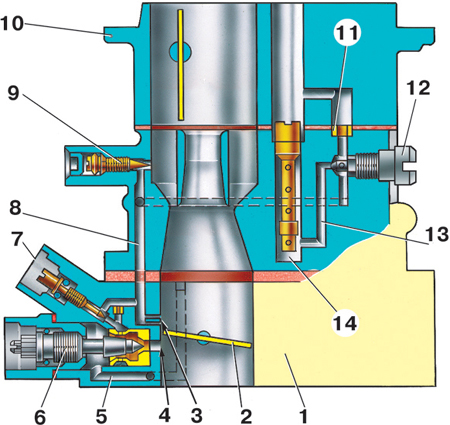
Float chamber
In the design of any carburetor, a float chamber is provided, in which a float is located that controls the fuel level. Despite the simplicity of this system, there are times when the fuel level is not at the optimum level. This is due to a violation of the tightness of the needle valve. The reason for this is the operation of the car on poor quality fuel. The problem is eliminated by cleaning or replacing the valve. The float itself needs adjustment from time to time.
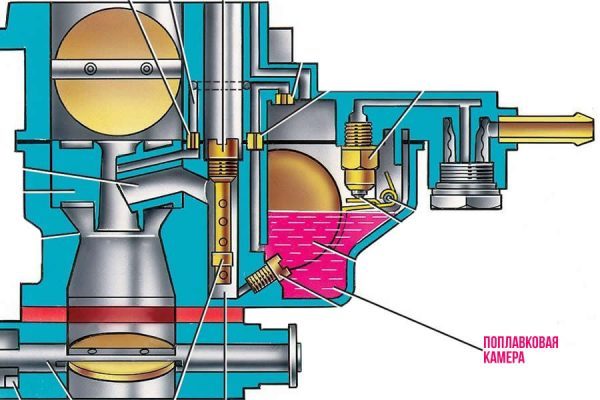
Econostat
Econostat supplies the engine with fuel when operating at high speeds and delivers a fuel-air mixture in proportions corresponding to the speed. By its design, the econostat consists of a tube with different sections and emulsion channels located at the top of the mixing chamber. At maximum engine loads, a vacuum occurs in this place.
Accelerator pump
So that when the gas pedal is pressed sharply, there is no failure, an accelerator pump is provided in the carburetor, which provides additional fuel. The need for this mechanism is due to the fact that the carburetor, with sharp acceleration, is not able to supply the required amount of fuel to the cylinders.
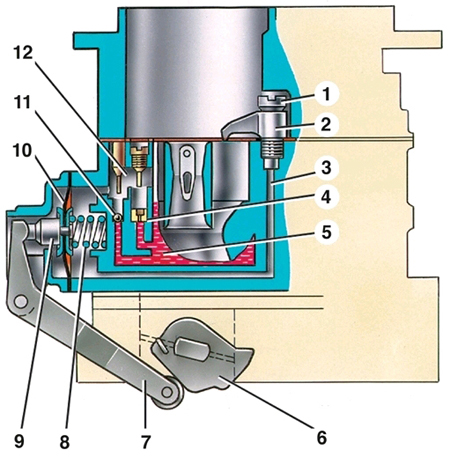
Transition system
Transitional systems in the carburetor enrich the combustible mixture during the transition from idling to the operation of the main metering systems, with a smooth press on the accelerator pedal. The fact is that when the throttle valve is opened, the amount of air passing through the diffuser of the main dosing system increases. Although the vacuum is created, it is not enough for the fuel to drain from the atomizer of the main metering chamber. The combustible mixture is depleted due to the large amount of air in it. As a result, the engine may stall. With the second chamber, the situation is similar - when opening the throttle, it is necessary to enrich the fuel mixture in order to avoid dips.
Starting system
At the time of starting a cold carburetor engine, it is not always possible to ensure the supply of the required amount of fuel and air. To do this, the carburetor has a starting system that allows you to regulate the air supply using an air damper. This part is on the first camera and is adjusted with a cable from the salon. As the engine warms up, the damper opens.
Suction is a device that covers the inlet for supplying air to the carburetor when the engine is cold started.
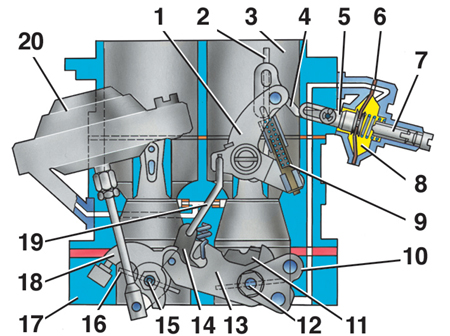
When the suction handle is pulled out, the mixture is enriched, but at the same time a gap of 0,7 mm remains so as not to flood the candles.
What carburetors are installed on the VAZ 2106
Despite the fact that the VAZ "six" has not been produced for a long time, a large number of these cars are found on the roads. Their owners often wonder what kind of carburetor can be installed instead of the standard one, while the following goals are pursued: to reduce fuel consumption, improve the dynamic performance of the car and, in general, achieve optimal performance. To realize these desires today is quite realistic, for which they are replacing the standard carburetor. Consider what modifications of the considered devices can be installed on the VAZ 2106.
DAAZ
At the beginning of the production of cars of the VAZ family, the power units worked in tandem with the carburetors of the Dmitrov Automobile Unit Plant (DAAZ). For the manufacture of these units, a license was acquired from the company Weber. On many "sixes" and today there are just such carburetors. They are characterized by good dynamics, simple design and high fuel consumption, usually at least 10 liters per 100 km. It is very problematic to buy such a carburetor in good condition. To assemble a normally functioning node, you will need to purchase several devices.
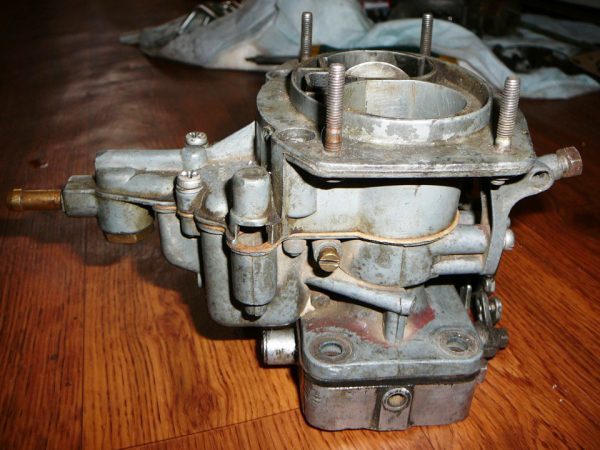
Learn more about the DAAZ carburetor: https://bumper.guru/klassicheskie-modeli-vaz/toplivnaya-sistema/karbyurator-daaz-2107–1107010-ustroystvo-i-regulirovka.html
Ozone
The Ozone carburetor was created based on Weber, but the assembly had distinctive features:
- fuel efficiency;
- reducing the toxicity of exhaust gases.
In those days, this carburetor was considered the most environmentally friendly. If the device is adjusted correctly, then the dynamics should be good, and the fuel consumption should be 7-10 liters per 100 km. Despite the positive qualities, the knot also has disadvantages. The fact is that the secondary chamber opens with the help of a pneumatic actuator, which sometimes refuses to work. In addition, there are problems with the forced idle system due to diaphragm wear.

If the adjustments are violated or the mechanism is dirty, the secondary chamber may not open at all or open, but with a long delay. As a result, the dynamics worsens, stable operation of the engine at medium and high speeds is disturbed. In order for the Ozone carburetor to work flawlessly, the assembly must be serviced periodically.
More about the Ozone carburetor: https://bumper.guru/klassicheskie-modeli-vaz/toplivnaya-sistema/karbyurator-ozon-2107-ustroystvo.html
Solex
DAAZ-21053 (Solex) carburetors are especially popular with Zhiguli owners. The device has good indicators of dynamics and efficiency. For the "six" is one of the best options. Compared to previous carburetors, Solex has a design difference, because it is equipped with a fuel return system: it provides fuel back to the fuel tank. As a result, it is possible to save about 400–800 g of gasoline per 100 km.
Some Solex modifications were equipped with an idle solenoid valve, an automatic cold start system.
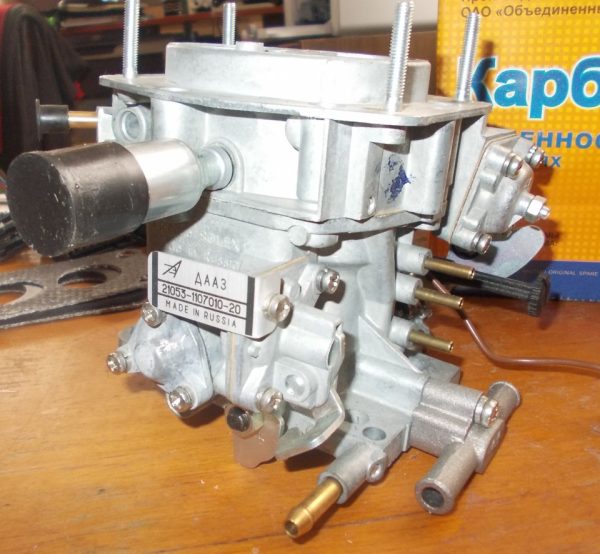
The operation of such a carburetor showed that the device is rather capricious due to the narrow fuel and air channels, which are often clogged. As a result, there are problems with idling, and later other problems. Fuel consumption is 6-10 liters per hundred with measured driving. In terms of dynamics, Solex is second only to Weber of the first years of production. In order for this carburetor to work flawlessly, it is necessary to carry out preventive maintenance in a timely manner.
Learn more about Solex: https://bumper.guru/klassicheskie-modeli-vaz/toplivnaya-sistema/karbyurator-soleks-21073-ustroystvo.html
Installation of two carburetors
The owners of the Zhiguli, who are not satisfied with the operation of the engine at high speeds, are thinking about installing two units for mixing fuel and air. The fact is that in a standard intake manifold, the channels have different lengths, and this does not allow the engine to develop full power. The introduction of two carburetors provides a more uniform supply of the fuel-air mixture, which increases the torque and power of the power unit.
If you are interested in upgrading your "six", you need to know that such work can be done independently. It will require patience, the necessary materials and components. The installation of two carburetors requires the following list:
- two intake manifolds from the Oka car;
- tees for the fuel system;
- throttle actuator parts;
- a set of hoses and tees;
- a strip of metal 3–4 mm thick.

In addition to the above, you need to prepare a set of standard tools (screwdrivers, keys, pliers), as well as a vise, a drill and a cutter for metal. As for the choice of carburetor, you need to install two identical models, for example, Ozone or Solex. The installation process begins with the removal of the standard intake manifold and fitting parts from the Oka so that they fit snugly against the cylinder head.
For convenience of work, it is recommended to remove the block head.
When preparing the intake manifolds, close attention is paid to the channels: the surface should not have any protruding elements. Otherwise, during engine operation, the flow of the mixture will experience resistance. All interfering parts must be removed with a cutter. Having completed all the preparatory procedures, the carburetors are installed. Then the devices are adjusted, for which the quality and quantity screws are unscrewed by the same number of revolutions. In order for both devices to open at the same time, it is necessary to make a bracket that will be connected to the gas pedal. A suitable cable is used as a drive for carburetors, for example, from a Tavria car.
Signs of a malfunctioning carburetor
As a car with a carburetor is used, certain problems may occur as a result of which cleaning, adjustment of the assembly or replacement of any of its parts is required. Consider the most common problems with the mechanism and methods for their elimination.
Stalls at idle speed
One of the most common malfunctions of VAZ 2106 carburetors and other "classics" is idling problems. In this situation, the following happens: when the gas pedal is pressed, the engine normally picks up speed, and when released, the engine stalls, that is, when the idle mode (XX) is switched. There may be several reasons for this phenomenon:
- blockage of jets and channels of the XX system;
- malfunction of the solenoid valve;
- problems with the forced stroke economizer;
- failure of the quality screw seal;
- the need for adjustment of the node.

The design of the carburetor is made with the combination of the XX system and the primary chamber. As a result, malfunctions can occur, leading not only to failures, but also to a complete stop of the motor. The solution to these problems is quite simple: replacing faulty elements, if necessary, cleaning and purging the channels with compressed air.
Acceleration crashes
When accelerating the car, failures may occur, which are a drop in acceleration or a complete stop of the car.
Failures can be different in duration - from 2 to 10 seconds, jerks, twitching, rocking are also possible.
The main cause of this problem is a poor or rich fuel mixture entering the cylinders of the power unit at the moment the gas pedal is pressed.
First of all, it is worth noting that failures can be caused not only by carburetor malfunctions, but also by clogging or malfunction of the fuel system, as well as the ignition system. Therefore, you first need to check them and only after that take on the repair of the carburetor. The most likely cause of failures of the VAZ 2106 may be a clogged hole in the main fuel jet (GTZ). When the engine is running under light loads or in idle mode, the amount of fuel consumed is small. At the moment of pressing the gas pedal, high loads occur, as a result of which fuel consumption increases sharply. If the GTZ is clogged, the passage hole will decrease, which will lead to a lack of fuel and engine failures. In this case, the jet must be cleaned.
The appearance of dips can also be caused by clogged fuel filters or loose fuel pump valves. If there is air leakage in the power system, then the problem in question is also quite likely. If the filters are clogged, they can simply be replaced or cleaned (mesh at the carburetor inlet). If the problem is caused by the fuel pump, the mechanism will need to be repaired or replaced with a new one.

As for air leakage, this happens, as a rule, through the intake manifold. It is necessary to check the tightness of the connection between the carburetor and the manifold. To do this, with the engine running, spray WD-40 on the connections between the manifold, gaskets and carburetor from all sides. If the liquid leaves too quickly, then there is a leak in this place. Next, you need to remove the carburetor and fix the problem (align it under pressure or resort to improvised means).
Video: elimination of air leakage
Fills the candles
The problem with flooded spark plugs is familiar to almost every owner of a car with a carburetor engine. In this situation, it is quite difficult to start the unit. When turning out the candle, you can see that the part is wet, that is, filled with fuel. This indicates that the carburetor is supplying a rich fuel mixture at the time of starting. In such a situation, the appearance of a normal spark is impossible.
The problem with flooded candles can occur both during a cold start of the engine and when it is hot.


Since there may be several reasons for this phenomenon, it is worth considering them in more detail:
- Starting the engine with the choke extended. If the choke is closed on a warm engine, then a re-enriched mixture will be supplied to the cylinders, which will lead to the flooding of the spark plugs.
- Malfunction or need to adjust the starting device. The problem in this case manifests itself, as a rule, on a cold one. In order for the starter to be properly adjusted, the starting gaps must be properly set. The launcher itself must have an intact diaphragm and a sealed housing. Otherwise, the air damper at the time of starting a cold unit will not open at the prescribed angle, thereby depleting the fuel mixture by mixing in air. If there is no such a half-opening, then the mixture will become enriched upon cold start. As a result, the candles will be wet.
- Spark plug failure. If the candle has black soot, an incorrectly set gap between the electrodes, or it is completely pierced, then the part will not be able to ignite the fuel-air mixture and at the time the engine is started it will be filled with gasoline. This indicates the need to have a set of spark plugs in stock so that replacement can be carried out if necessary. With such a malfunction, the part will be wet both cold and hot.
- Needle valve malfunctions. If the carburetor needle valve in the float chamber has lost its tightness and passes more fuel than it should, the fuel mixture becomes rich during start-up. If this part fails, the problem can be observed during cold and hot starts. Valve leaks can often be identified by the smell of gasoline in the engine compartment, as well as by smudges of fuel on the carburetor. In this case, the needle must be checked and, if necessary, replaced.
- Overflows the fuel pump. If the fuel pump drive is not adjusted correctly, the pump itself can pump fuel. As a result, excessive pressure of gasoline is created on the needle valve, which leads to an increase in fuel in the float chamber and an enrichment of the fuel mixture. To fix the problem, you need to adjust the drive.
- Clogged air jets of the main dosing system (GDS). GDS air jets are necessary to supply air to the fuel mixture so that it has the necessary proportions of gasoline and air for normal engine start. The lack of air or its complete absence due to clogging of the jets leads to the preparation of an enriched combustible mixture and the filling of candles.
The smell of gasoline in the cabin
Owners of the VAZ 2106 and other "classics" sometimes encounter such a nuisance as the smell of gasoline in the cabin. The situation requires an urgent search and elimination of the problem, since fuel vapors are harmful to human health and explosive. There can be several reasons for this smell. One of them is damage to the fuel tank, for example, as a result of a crack. Therefore, the container must be checked for leakage and, if a damaged area is found, repaired.


The smell of gasoline can also be caused by leakage of fuel from the fuel line (hoses, tubes), which over time could simply become unusable. Attention should also be paid to the fuel pump: if the membrane is damaged, gasoline may leak and smell can enter the passenger compartment. Over time, the fuel pump rod wears out, which requires adjustment work. If the procedure is not performed correctly, fuel will overflow, and an unpleasant smell will appear in the cabin.
Stalls when you press the gas
There are many reasons for a stalling engine when you press the gas pedal. These may be:
- clogging of the accelerator pump jets;
- incorrect adjustment of the twentieth;
- blockage of the transition system.
In addition, the reason may be in the distributor itself, for example, due to poor contact. As for the carburetor, it is necessary to clean and blow through all the holes in it, check the markings of the jets with the table for a specific modification and, if necessary, install the appropriate part. Then the ignition is adjusted, having previously set the gap on the distributor cams, the carburetor is also adjusted (quality and quantity of fuel).
Video: Troubleshooting a stalling engine


Watch this video on YouTube
Adjusting the carburetor VAZ 2106
The performance of the power unit under any operating conditions directly depends on the correct adjustment of the carburetor. This suggests that before taking up a tool and turning any screws, you need to understand which part is responsible for what. In addition, you will need to prepare tools:
- a set of screwdrivers (flat, Phillips);
- set of open-end wrenches;
- a set of round probes or drills of different diameters;
- rubber bulb;
- toothpicks;
- capacity for washing the mechanism;
- calipers
- tweezers;
- ruler;
- rags.
XX adjustment
Idle speed adjustment is carried out with quality and quantity screws. The procedure consists of the following steps:
- We start the engine and warm it up to an operating temperature of 90 ° C, after which we turn it off.

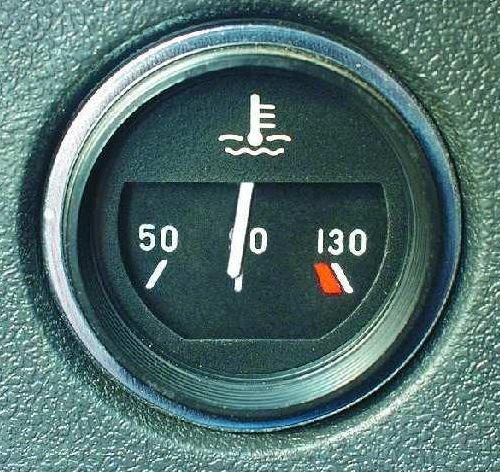 We start the engine and warm it up to an operating temperature of 90 ° C
We start the engine and warm it up to an operating temperature of 90 ° C - We find the quality and quantity screws on the carburetor body and tighten them until they stop. Then we turn the first of them 5 turns, the second - 3.

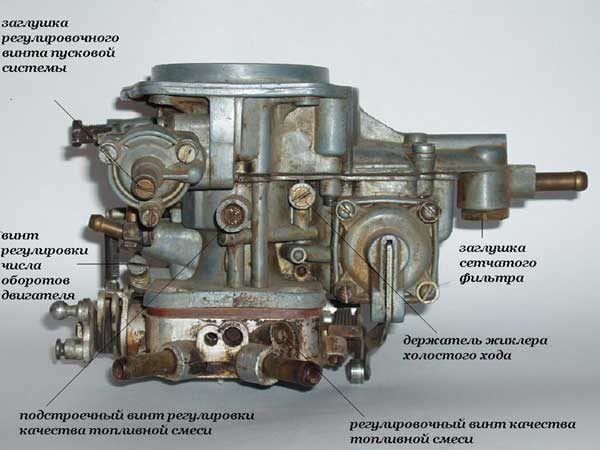 Idling adjustment is made by screws for the quality and quantity of the mixture
Idling adjustment is made by screws for the quality and quantity of the mixture - We start the engine and use the quantity screw to set the speed on the tachometer within 800 rpm.
- We twist the quality screw until the speed starts to fall, after which we unscrew it by 0,5 turns.
Video: how to make idling stable


Watch this video on YouTube
Float chamber adjustment
One of the primary procedures when setting up a carburetor is adjusting the float chamber. With a high level of gasoline in the chamber, the fuel mixture will be rich, which is not the norm. As a result, toxicity and fuel consumption increase. If the level is less than it should be, then at different engine operating modes, gasoline will not be enough. In this case, it is necessary to adjust the float tongue so that it has a stroke of 8 mm. It will be useful to remove the float, remove the needle and inspect it for defects. If the carburetor overflows, then it is better to replace the needle.
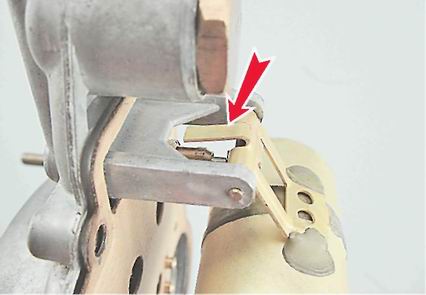

Accelerator pump adjustment
After the float chamber is adjusted, it is necessary to check the performance of the accelerator pump. To do this, the carburetor is dismantled from the engine and the top cover is removed from it. The pump is checked in the following order:
- We prepare a bottle of pure gasoline, substitute an empty container under the carburetor, fill the float chamber halfway with fuel.

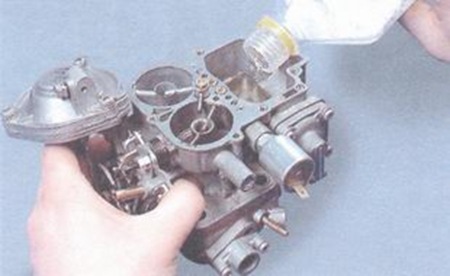 To adjust the accelerator pump, you will need to fill the float chamber with fuel
To adjust the accelerator pump, you will need to fill the float chamber with fuel - We move the throttle actuator lever several times so that gasoline enters all channels that ensure the operation of the accelerating pump.

 In order for fuel to enter all channels, it is necessary to move the throttle actuator lever several times
In order for fuel to enter all channels, it is necessary to move the throttle actuator lever several times - We turn the throttle lever 10 times, collecting the escaping gasoline into a container. Then, using a medical syringe, we measure the volume. During normal operation of the accelerator, the indicator should be 5,25–8,75 cm³.

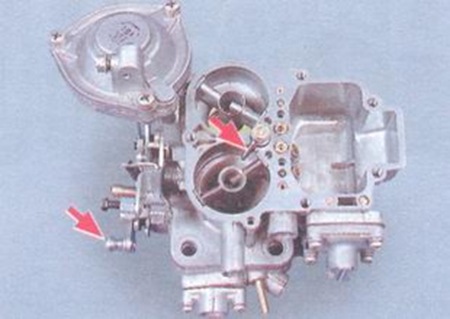 We check the performance of the accelerator pump by moving the throttle lever counterclockwise
We check the performance of the accelerator pump by moving the throttle lever counterclockwise
When checking the accelerator, you should pay attention to where the jet is directed, what shape and quality it is. With normal flow, it should be smooth without any deviations and gasoline spraying. In case of any violations, the accelerator sprayer must be replaced with a new one. Structurally, the carburetor has an adjustment screw in the form of a cone bolt, when screwed in, the opening of the bypass jet is blocked. With this screw, you can change the fuel supply by the accelerator pump, but only down.
Cleaning or replacing jets
The carburetor, as it is used, needs to be cleaned and purged with air every 10 thousand km. run. Today, a lot of tools are offered for cleaning without dismantling the assembly from the car. But as a rule, they help only with minor pollution. With more serious blockages, removing the device is indispensable. After dismantling and disassembling the carburetor, the strainer and jets are unscrewed and cleaned. As a cleaning agent, you can use gasoline, and if it does not help, a solvent.
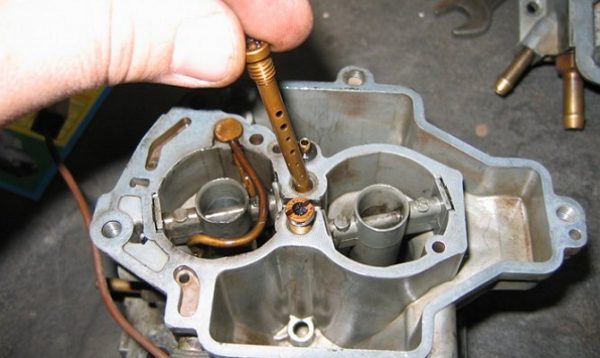

In order not to disturb the diameter of the passage holes of the jets, do not use metal objects such as a needle or wire for cleaning. The best option would be a toothpick or a plastic stick of a suitable diameter. After cleaning, the jets are blown with compressed air so that no debris remains.
Video: how to clean a carburetor


Watch this video on YouTube
At the end of the entire procedure, the jets are checked for compliance with the installed carburetor. Each part is marked in the form of a series of numbers that indicate the throughput of the holes.
Table: numbers and sizes of nozzles for carburetors VAZ 2106
| Carburetor designation | Fuel jet of the main system | Main system air jet | Idle fuel jet | Idle air jet | Accelerator pump jet | |||||
| 1 room | 2 room | 1 room | 2 room | 1 room | 2 room | 1 room | 2 room | fuel | bypass | |
| 2101 – 1107010 Feet | 135 | 135 | 170 | 190 | 45 | 60 | 180 | 70 | 40 | 40 |
| 2101 – 1107010 – 02 | 130 | 130 | 150 | 190 | 50 | 45 | 170 | 170 | 50 | 40 |
| 2101-1107010-03; 2101 – 1107010 – 30 | 130 | 130 | 150 | 200 | 45 | 60 | 170 | 70 | 40 | 40 |
| 2103 – 1107010 Feet | 135 | 140 | 170 | 190 | 50 | 80 | 170 | 70 | 40 | 40 |
| 2103-1107010-01; 2106 – 1107010 Feet | 130 | 140 | 150 | 150 | 45 | 60 | 170 | 70 | 40 | 40 |
| 2105 – 1107010 – 10 | 109 | 162 | 170 | 170 | 50 | 60 | 170 | 70 | 40 | 40 |
| 2105-110711010; 2105-1107010; 2105 – 1107010 – 20 | 107 | 162 | 170 | 170 | 50 | 60 | 170 | 70 | 40 | 40 |
| 21053 | 100 | 115 | 150 | 135 | 35 – 45 Feet | 50 | 140 | 150 | 45 | 40 |
| 2107-1107010; 2107 – 1107010 – 20 | 112 | 150 | 150 | 150 | 50 | 60 | 170 | 70 | 40 | 40 |
| 2107 – 1107010 – 10 | 125 | 150 | 190 | 150 | 50 | 60 | 170 | 70 | 40 | 40 |
| 2108 – 1107010 Feet | 97,5 | 97,5 | 165 | 125 | 42±3 | 50 | 170 | 120 | 30/40 | — |
Replacing the carburetor
The reasons for removing the assembly may be different: replacement with a product of a different modification, repair, cleaning. In any case, you must first remove the air filter. To carry out the replacement work, you will need the following tools:
- open-end wrench for 13;
- crosshead screwdriver;
- heads for 8 and 10;
- crank;
- small extension.
How to remove
After the preparatory measures, you can proceed to dismantle:
- We turn off 4 nuts of fastening of the case of the air filter and we take out a plate.

 To remove the air filter housing, you will need to unscrew 4 nuts and remove the plate
To remove the air filter housing, you will need to unscrew 4 nuts and remove the plate - We unscrew the clamp and remove the crankcase exhaust hose.
- We dismantle the warm air intake pipe and the air filter housing.

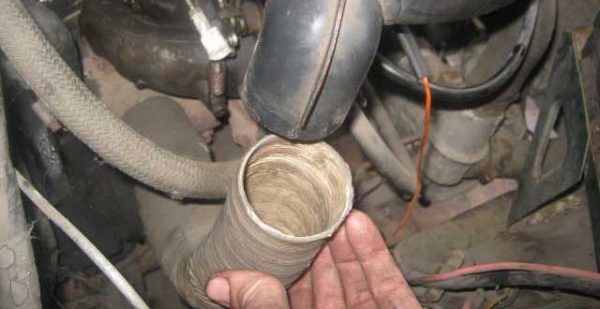 We dismantle the warm air intake pipe and the air filter housing
We dismantle the warm air intake pipe and the air filter housing - We unscrew the clamp of the fuel supply hose, and then pull it off the fitting.

 Remove the fuel supply hose from the fitting
Remove the fuel supply hose from the fitting - Disconnect the thin tube coming from the ignition distributor.

 The thin tube coming from the ignition distributor must be removed
The thin tube coming from the ignition distributor must be removed - Remove the wire from the solenoid valve.

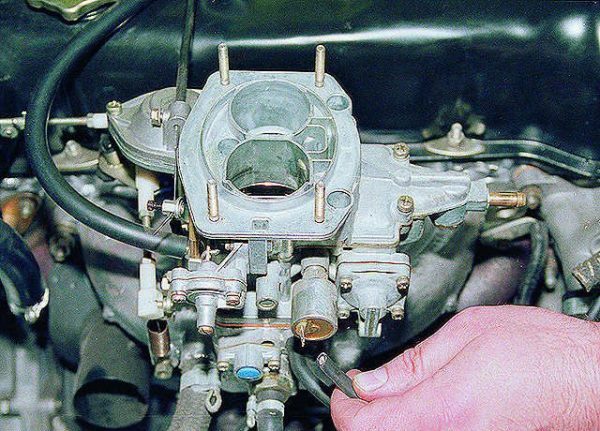 Disconnect the wire from the solenoid valve
Disconnect the wire from the solenoid valve - We disconnect the lever and the throttle control rod, for which it is enough to apply a little effort and pull the rod to the side.
- We release the suction cable by loosening 2 screws.

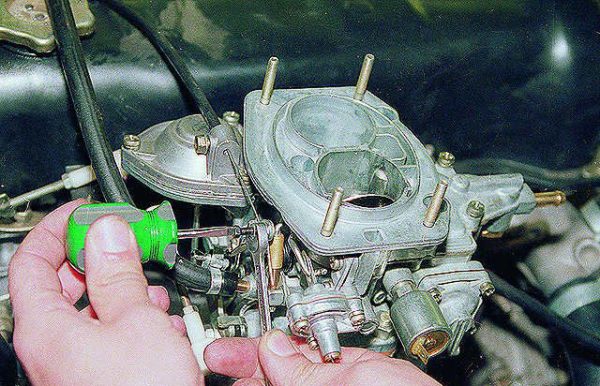 To loosen the suction cable, you need to unscrew 2 screws
To loosen the suction cable, you need to unscrew 2 screws - There is a spring between the intake manifold and the carburetor rod - remove it.

 We remove the return spring, which stands between the intake manifold and the carburetor rod.
We remove the return spring, which stands between the intake manifold and the carburetor rod. - We turn off 4 nuts securing the carburetor to the manifold with a key of 13.

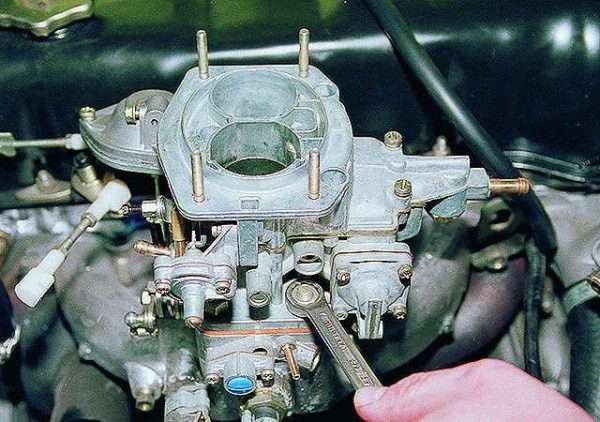 To dismantle the carburetor, unscrew the 4 nuts securing to the intake manifold
To dismantle the carburetor, unscrew the 4 nuts securing to the intake manifold - We take the carburetor by the body and lift it, removing it from the studs.

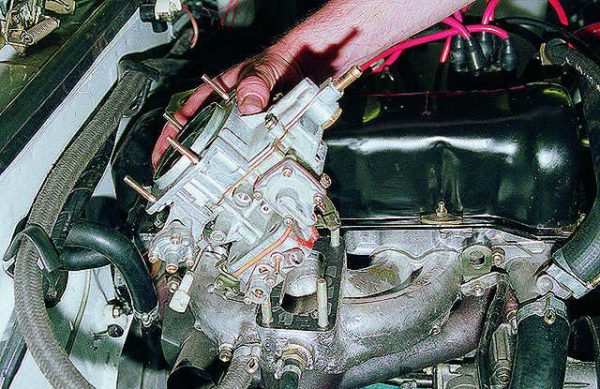 After unscrewing the nuts, remove the carburetor by taking it by the body and pulling it up
After unscrewing the nuts, remove the carburetor by taking it by the body and pulling it up
After dismantling the device, procedures are carried out to replace or repair the assembly.
Video: how to remove a carburetor using the example of a VAZ 2107


Watch this video on YouTube
How to put
Installation of the product is carried out in the reverse order. When tightening the nuts, do not use much force. Fasteners are tightened with a torque of 0,7–1,6 kgf. m. The fact is that the mating plane of the carburetor is made of soft metal and can be damaged. Before installing the assembly, the gasket is replaced with a new one.
Today, carburetor engines are no longer produced, but there are a lot of cars with such units. On the territory of Russia, the most common are the "Lada" classic models. If the carburetor is serviced correctly and in a timely manner, the device will work without any complaints. In the event of breakdowns with their elimination, it is not worth delaying, since the operation of the motor is destabilized, fuel consumption increases, and dynamic characteristics deteriorate.

